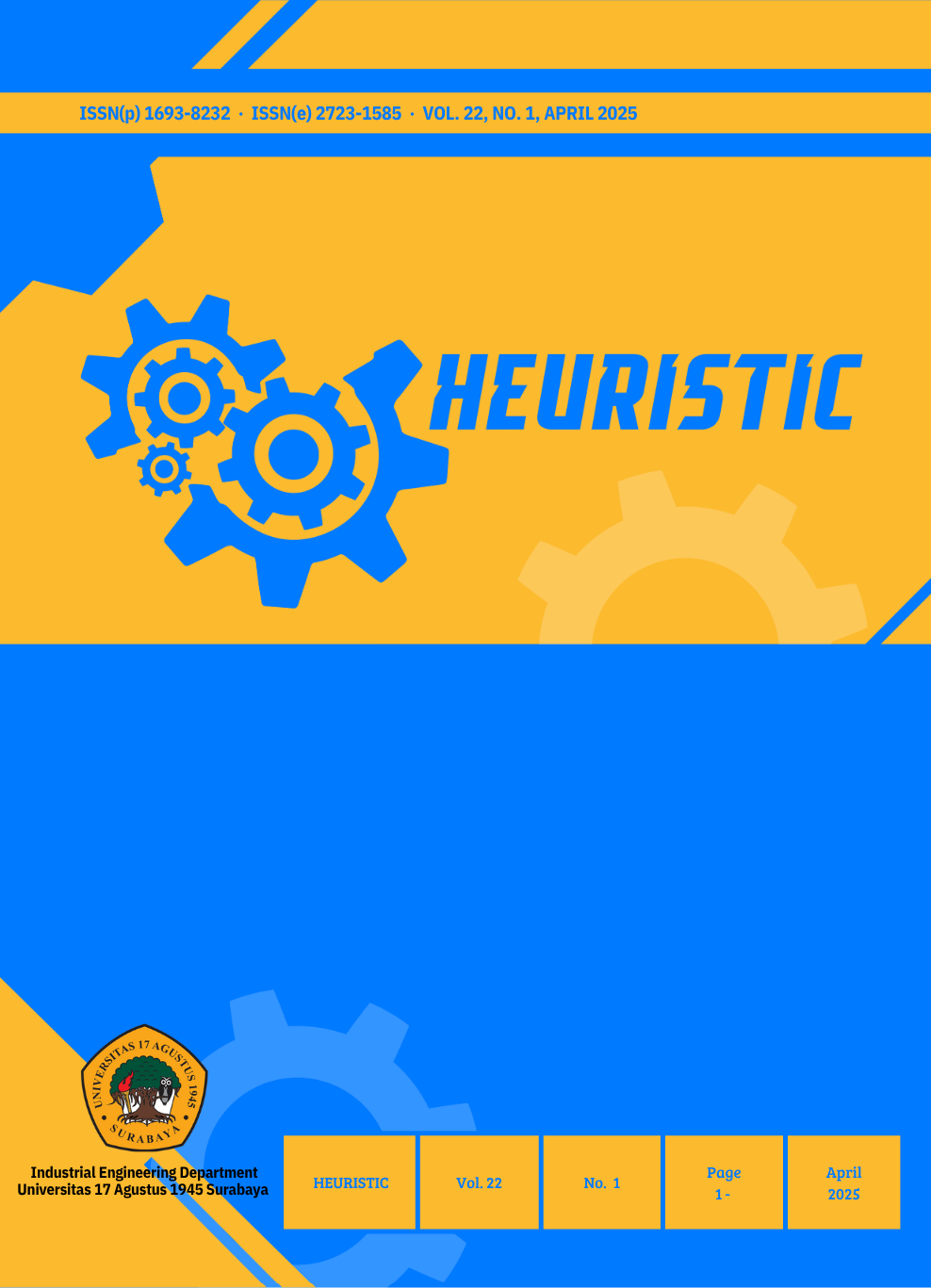Application of Six Sigma for Quality Optimization in Textile Raw Material: A Case Study on TRC 1 Yarn
Abstract
This study aims to analyze quality control in the production process of TRC 1 yarn at PT. SA by implementing the Six Sigma approach. The TRC 1 product exhibits a defect (reject) rate of 4.1%, which significantly exceeds the company's standard of 1%. The research adopts the DMAIC method (Define–Measure–Analyze–Improve–Control). The measurement phase involves the creation of histograms, both attribute and variable control charts, and the calculation of DPMO and Cp. The results indicate that the process is statistically unstable, with a sigma level 2.2 and a DPMO of 245,000. The process capability index (Cpk) of 0.503 demonstrates that the process is incapable. Root Cause Analysis (RCA) and Failure Mode and Effect Analysis (FMEA) identified the primary causes as the absence of measuring instruments for raw material composition and the lack of a standard operating procedure (SOP) for machine inspections. The improvement phase was carried out using the 5W1H approach, resulting in solutions such as developing measurement tools, nozzle labeling, and issuing operational memos. After four months of implementation, the defect rate decreased to 3.24%. Although improvements were observed, the result still exceeds the company's target, indicating the need for continuous process control. This study contributes to applying Six Sigma for quality improvement in the integrated textile industry.Downloads
References
I. W. Ardhyani, S. A. Garini, F. Suhartiningrum, and Q. Akyun, "Identification of Production Decline Factors using the LEAN DMAI Method," Jurnal Ilmiah Teknik Industri, vol. 22, no. 1, pp. 76–85, Jun. 2023, doi: 10.23917/jiti.v22i1.20013.
S. Hakimi, S. M. Zahraee, and J. Mohd Rohani, "Application of Six Sigma DMAIC methodology in plain yogurt production process," International Journal of Lean Six Sigma, vol. 9, no. 4, pp. 562–578, Oct. 2018, doi: 10.1108/IJLSS-11-2016-0069.
A. Izza and D. Retnowati, “Analisis Kualitas Produk Furniture Dengan Pendekatan Metode Six Sigma,” Heuristic, vol. 18, no. 2, pp. 59–72, Oct. 2021.
D. Retnowati, Y. Purnomo, and A. F. Fudhla, "Six Sigma Implementation In 'Monosodium Glutamate' Production Systems," JISO: Journal Of Industrial And Systems Optimization, vol. 5, no. 1, pp. 68–76, Jun. 2022.
A. Chakrabarty and K. C. Tan, "The current state of six sigma application in services," 2007. doi: 10.1108/09604520710735191.
A. R. B. Prasetyo, J. Purnama, and I. W. Ardhiyani, “Penerapan Six Sigma Pada Proses Produksi Kertas Untuk Menganalisis Kualitas,” JISO: Journal Of Industrial And Systems Optimization, vol. 5, no. 2, pp. 130–135, Dec. 2022.
J. P. Costa, I. S. Lopes, and J. P. Brito, "Six Sigma application for quality improvement of the pin insertion process," in Procedia Manufacturing, A. Ryan, S. Gordon, and P. Tiernan, Eds., Elsevier B.V., 2019, pp. 1592–1599. doi: 10.1016/j.promfg.2020.01.126.
G. Jiménez-Delgado et al., “Implementation of Lean Six Sigma to Improve the Quality and Productivity in Textile Sector: A Case Study,” in Digital Human Modeling and Applications in Health, Safety, Ergonomics and Risk Management, V. G. Duffy, Ed., West Lafayette: Springer, Cham, Jul. 2023, pp. 395–412. doi: 10.1007/978-3-031-35741-1_30.
S. K. Hussein and I. W. R. Taifa, “Six Sigma methodology implementation for minimising yarn breakages in the apparel industry,” International Journal of Industrial and Systems Engineering, vol. 48, no. 2, pp. 228–258, 2024, doi: 10.1504/IJISE.2024.141596.
D. Retnowati, G. Wilujeng, M. Yusup, R. Sukwadi, and M. B. Wahju, “Analisis Produktivitas Produk Obat Herbal Dengan Pendekatan Objective Matrix (OMAX) Dan Root Cause Analysis (RCA),” heuristic, vol. 20, pp. 37–48.
A. J. Card, "The problem with '5 whys,'" BMJ Quality & Safety Online First, pp. 1–7, 2016, doi: 10.1136/bmjqs.
S. Hassan, J. Wang, C. Kontovas, and M. Bashir, "Modified FMEA hazard identification for cross-country petroleum pipeline using Fuzzy Rule Base and approximate reasoning," J Loss Prev Process Ind, vol. 74, p. 104616, 2022, doi: https://doi.org/10.1016/j.jlp.2021.104616.
J. S. da Motta Reis, D. E. Werderits Silva, N. A. de Souza Sampaio, J. G. M. de Barros, G. Santos, and L. C. F. Motta Barbosa, “The Benefits Of Fmea In Improving The Industrial Process Of A Cabin Air Carrier,” Proceedings on Engineering Sciences, vol. 6, no. 3, pp. 1031–1040, Aug. 2024, doi: 10.24874/PES06.03.016.
S. Lounis, A. Koukopoulos, T. Farmakis, and M. Aryblia, "Evaluation Methodology for Circular and Resilient Information Systems," Applied Sciences (Switzerland), vol. 14, no. 17, Sep. 2024, doi: 10.3390/app14178089.
Authors who publish with Heuristic agree to the following terms:
- Authors transfer the copyright and grant the journal right of first publication with the work simultaneously licensed under a Creative Commons Attribution-ShareAlike 4.0 International License.. that allows others to share the work with an acknowledgement of the work's authorship and initial publication in this journal.
- Authors are able to enter into separate, additional contractual arrangements for the non-exclusive distribution of the journal's published version of the work (e.g., post it to an institutional repository or publish it in a book), with an acknowledgement of its initial publication in this journal.
- Authors are permitted and encouraged to post their work online (e.g., in institutional repositories or on their website) prior to and during the submission process, as it can lead to productive exchanges, as well as earlier and greater citation of published work (See The Effect of Open Access)







